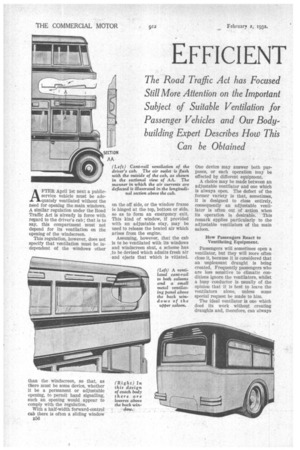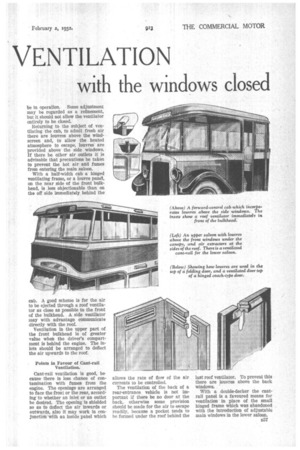EFFICIENT VENTILATION
Page 114

Page 115

Page 116

If you've noticed an error in this article please click here to report it so we can fix it.
with the windows closed
The Road Traffic Act has Focused Still More Attention on the Important Subject of Suitable Ventilation for Passenger Vehicles and Our Bodybuilding Expert Describes How This
Can be Obtained
AFTER April 1st next a publicservice vehicle must be adequately ventilated without the need for opening the main windows. A similar regulation under the Road Traffic Act is already in force with regard to the driver's cab ; that is to say, this compartment must not depend for its ventilation on the opening of the windscreen.
This regulation, however, does not specify that ventilation must be independent of the windows other than the windscreen, so that, as there must be some device, whether it be a permanent or adjustable opening, to permit hand signalling, such an opening would appear to comply with the regulation.
With a half-width forward-control cab there is often a sliding window E56 on the off side, or the window frame is hinged at the top, bottom or side, so as to form an emergency exit. This kind of window, if provided with an adjustable stay, may be used to release the heated air which arises from the engine.
Assuming, however, that the cab is to be ventilated with its windows and windscreen shut, a scheme has to be devised which admits fresh air • and ejects that which is vitiated. One device may answer both purposes, or each operation may be effected by different equipment.
A choice may be made between an adjustable ventilator and one which is always open. The defect of the former variety is that, sometimes, it is designed to close entirely, consequently an adjustable ventilator is often out of action when its operation is desirable. This remark applies particularly to the adjustable ventilators of the main saloon.
How Passengers React to Ventilating Equipment.
Passengers will sometimes open a ventilator, but they will more often close it, because it is considered that an unpleasant draught is being created. Frequently passengers who are less sensitive to climatic conditions ignore the ventilators, whilst a busy conductor is usually of the opinion that it is best to leave the ventilators alone, unless some special request be made to him.
The ideal ventilator is one which doe .4 its work without creating draughts and, therefore, can always
be in operation. Some adjustment may be regarded as a refinement, but it should not allow the ventilator entirely to be closed.
Returning to the subject of ventilating the cab, to admit fresh air there are louvres above the windscreen and, to allow the heated atmosphere to escape, louvres are provided above the side windows. If there be other air outlets it is advisable that precautions be taken to prevent the hot air and fumes from entering the main saloon.
With a half-width cab a hinged ventilating frame, or a louvre panel, on the near side of the front bulkhead, is less objectionable than on the off side immediately behind the
cab. A good scheme is for the air to be ejected through a roof ventilator as close as possible to the front of the bulkhead. A side ventilator may with advantage communicate directly with the roof.
Ventilation in the upper part of the front bulkhead is of greater value when the driver's compartment is behind the engine. The inlets should be arranged to deflect the air upwards to the roof.
Points in Favour of Cant-rail Ventilation.
Cant-rail ventilation is good, because there is less chance of contamination with fumes from the engine. The openings are arranged to face the front or the rear, according to whether an inlet or an outlet be desired. The opening is shielded so as to deflect the air inwards or outWards, also it may work in conjunction with an inside panel which allows the rate of flow of the air currents to be controlled.
The ventilation of the back of a rear-entrance vehicle is not important if there be no door at the back,. otherwise some provision should be made for the air to escape readily, because a pocket tends to be formed under the roof behind the last roof ventilator. To prevent this there are louvres above the back windows. '
With a double-decker the cantrail panel is a favoured means for ventilation in place of the small hinged frame which was abandoned , with the introduction of adjustable main windows in the lower saloon. For the upper saloon it is advisable to fix tile front windows, but there is room above them for louvres which may be fully exposed with a roof finished flush, or shielded by au overhanging canopy.
When the louvres are protected by the canopy, the rate of flow of the incoming air currents is reduced by the opposing force of the air flowing over the roof ; this tends to draw air away from under the canopy. This is not a disadvantage, because it is better to depend on a moderate flow of air at many openings rather than on a strong current concentrated at one or two points. The roof ventilator is practically standardized equipment for the single-decker. It is also used for the upper saloon of the double-decker, where it is mounted at the sides of the roof so that it does not increase the overall height of the vehicle.
A ventilated cant-rail is seldom adopted for the upper saloon, but, as the sides of the compartment usually slope inwards towards the top, there Is room for louvres if they be compactly designed.
The driver's cab of a doubledecker cannot have a roof outlet like that of a single-decker, but an air duct of flat section may be arranged to lead to the upper-saloon roof. As an alternative, the off-side cant-rail of the cab may have an air extractor with a deflector on the inside to increase the rate of flow.
If the ventilating scheme is to include the doors, the folding type, such as is mechanically operated, has openings in the top rail, which is made an inch or two deeper than usual.
A coach-type door which hinges outwards is ventilated in a similar manner, but, as a large door top would look unsightly, the ventilator is restricted to a single opening or a small perforated metal panel.




































































































































































